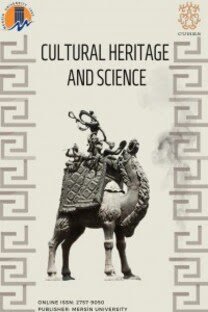The Transmission of the Technology for Gothic Masonry Vaulting to Greece, in the Case of Saint Sophia in Andravida, Elis
The church of Saint Sophia in Andravida, built around the mid-13th century in Elis, Western Greece has its still-remaining apse roofed in ribbed cross vaults. Built by the Frankish Princes of Achaia who occupied in the 13th and 14th century an area dominated by the native Byzantine architecture, Saint Sophia shows the great effort and attention paid in transferring new architectural forms and technology into a politically and culturally alien environment. This paper discusses the vaults’ construction and structural behaviour and explores questions around the technology transfer mechanisms from Western workshops. Although efficient, the vaults appear rather basic, and conservative compared to the contemporary endeavour to gradual disintegrate the envelope in Gothic architecture in Western Europe. On the whole, the analysis of the geometry, construction and structural performance showed a well-executed design with direct local input only at the construction stage.
Keywords:
Technology transmission, Gothic, Vaults Andravida, Morea,
___
- Athanasoulis D (2005). Glarentza. Patras: Hellenic Ministry of Culture, 6th Ephorate of Byzantine Antiquities.
- Athanasoulis, D. (2013). The Triangle of Power: Building Projects in the Metropolitan Area of the Crusader Principality of the Morea . In Viewing the Morea : land and people in the late medieval Peloponnese /edited by Sharon E. J. Gerstel.
- Bon, A., (1969): La Morée Franque: Recherches historiques, topographiques et archéologiques sur la principauté d’Achaïa (1205-1430). Paris: Boccard
- Branner, R., (1960): Burgundian Gothic Architecture. London: Α. Zwemmer.
- Campbell, S. D. (2018). The Cistercian Monastery of Zaraka, Greece, edited by Sheila Campbell. Kalamazoo, MI: Medieval Institute Publications, May 2018.
- Christianike Archailogike Hetaireia (1892), Δελτίον Α’ (Deltion A’) 1892.
- Cooper, N. (1996) ‘The Frankish church of Haghia Sophia at Andravida’ in The Archaeology of Medieval Greece Oxbow Monographs in Archaeology 59, P. Lock and G. Sanders (eds), Michigan, pp. 29-48.Fletcher, B. 1999: A history of architecture. London: Architectural Press
- Coulson (1996). “The Dominican Church of Saint Sophia at Andravida,” in The Archaeology of Medieval Greece, ed. P. Lock and G. D. R. Sanders Oxford: Oxbow Monograph 59; pp 49-59
- Frankl, B (1962). Gothic architecture. Yale University Press
- Gerstel, S. (2001). “Art and Identity in the Medieval Morea,” in The Crusades from the Perspective of Byzantium and the Muslim World, ed. A. Laiou and R. Mottahedeh (Washington, D.C., 2001), pp 263-85.
- Gioles, N. (1987). Βυζαντινή ναοδομία (Byzantiné naodomía). Athens: Kardamitsas.
- Grossman, H., (2004): Building identity: architecture as evidence of cultural interaction between Latins and Byzantines in Medieval Greece, Ph.D. dissertation, University of Pennsylvania.
- Kakouris (1979). Αρχαιολογικό Δελτίο 1979 (Archaeological Report of 1979), Μέρος Α’: Μελέτες, p. 156.
- Kitsiki-Panagopoulos, B. (1979): Cistercian and Mendicant Monasteries in Medieval Greece. Chicago: University of Chicago Press.
- Lambros (1916). Ειδησεις. Νεος Ελληνομνημων. Vol 13, p. 477-81
- Lambros (1923). Συμμικτα. Νεος Ελληνομνημων. Vol 13, p. 101-3
- Mango, C., (1978): Byzantine Architecture. London: Faber & Faber/ Electa Editrice.
- Mersch, M. (2015). Churches as ‚Shared Spaces‘ in the Eastern Mediterranean (14th–15th cent.), in: Union in Separation – Diasporic Groups and Identities in the Eastern Mediterranean (1100–1800), hrsg. von Georg Christ, Franz Julius Morche, Roberto Zaugg, Wolfgang Kaiser, Stefan Burkhardt und Alexander Beihammer, Rom 2015, pp 498-524.
- Miller W. (1908). The Latins in the Levant. London: John Murray
- Morel-Fatio A. (1885) "Chronique de Moree," Libro de Los Fechos et Conquistas del Principado de la Morea, ed. Morel-Fatio, Paris
- Olympios and Schabel (2020). The Cistercian Abbeys of Zaraka and Isova in the Principality of Achaia. Frankokratia 1 (2020) 165-179.
- Ousterhout, R. (2010): Architecture and Cultural Identity in the Eastern Mediterranean. In „Hybrid cultures in medieval Europe“, edited by Michael Borgolte and Bernd Schneidmuller. Berlin: Akademie Verlag
- Ousterhout, R., (1999): Master builders of Byzantium. Princeton: Princeton University Press.
- Pouqueville F. (1827). Voyage de la Grèce. Second edition, Paris, 1826–1827, 6 vol.
- Rodd, R. (1907). The Princes of Achaia and the Chronicles of Morea A Study of Greece in the Middle Ages. London: Edward Arnold.
- Sheppard, C. D., (1985): The Frankish Cathedral of Andravida, Ellis, Greece, Jnl Soc. Architectural Historians, vol. 44(3), pp. 205-220
- Sheppard, C. D., (1986): Excavations at the Cathedral of Haghia Sophia, Andravida, Greece, Gesta, vol. 25(1), Essay in Honor of Whitney Stow Stobbard, pp. 139-144
- The Institution of Structural Engineers (IStructE) (2005). Manual for the design of plain masonry in building structures. Second Edition. London: The Institution of Structural Engineers
- Theodossopoulos D. (2009). “Aspects of transfer of Gothic masonry vaulting technology to Greece in the case of Saint Sophia in Andravida”, Proc. Third Int. Congress Constr. History, Cottbus, May 2009
- Theodossopoulos, D., (2008): Structural design of High Gothic vaulting systems in England, Int. Jnl. Architectural Heritage, 2: 1–24, 2008, Taylor & Francis.
- Theodossopoulos, D., Sinha, B. P., and Usmani, A. S., (2003): Case Study of the Failure of a Cross Vault: Church of Holyrood Abbey, Jnl. Architectural Engrg, Am. Soc. Civil Engineers (ASCE), vol. 9(3), pgs. 109-117.
- Traquair, R., (1923): Frankish Architecture in Greece. RIBA Journal 31(2) pp. 33–50, and 31(3), pp. 73–86.
- Yayın Aralığı: Yılda 2 Sayı
- Başlangıç: 2020
- Yayıncı: Mersin Üniversitesi
